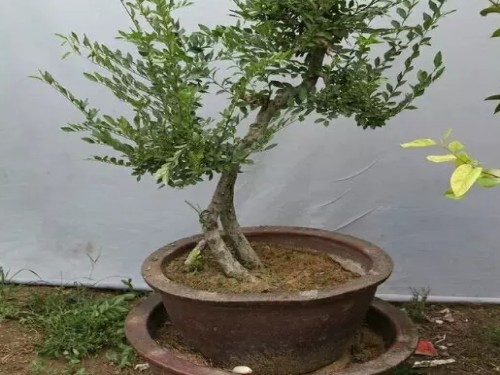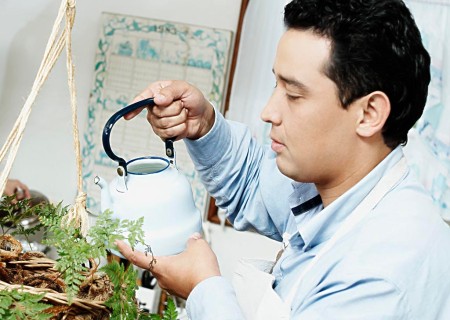Propagation methods of potted safe trees
Ping an tree is a kind of bright green and auspicious Lanyu cinnamon (cinnamon, ping an tree). "Ping an Tree" is the elegant name of Lanyu cinnamon. It has the role of potted ornamental plants, is one of the common family foliage plants, air conditioning is very good! People give it an auspicious name, "Ping an Tree", to cater to the consumption psychology of urban people who worship green, love beauty and look forward to peace, so as to relax people's nerves in tense work, eliminate fatigue, and reduce stress. therefore, it is very popular among urbanites, although it is expensive, it is still very popular.
The propagation and seedling methods of potted safe trees are as follows: sowing method, cutting method and striping method.
The propagation of Ping an tree is often carried out by sowing, and it is usually planted by trenching and sowing on demand. When the seedlings of the plant grow 3-4 true leaves, liquid fertilizer should be applied once a month, stop fertilization after autumn, do a good job of cold prevention, and overwinter at an indoor temperature of not less than 5 ℃.

In South China, ripe purple-black fruits can be sowed from September to October. After washing off the peel and pulp, the empty seeds are floated and spread out in a cool place to dry. If the seeds cannot be sowed immediately because of bad weather or the nursery is not ready, the seeds should be stored in wet sand and placed in a cool place to prevent seed mildew. After the seeds are exposed, the seeds will be sown or bagged.
For seeds that have not been germinated by sand storage, soak the seeds with 0.3% formalin solution for 30 minutes before sowing, pour out the excess liquid, seal it for 2 hours, rinse with clean water to remove the solution attached to the seed coat, and then soak the seeds with water for 24 hours. The germination rate can be increased. If the seeds are not disinfected, the seeds can be soaked in warm water of about 40 ℃, and the germination rate can also be increased.
It is usually ditched and sown on demand, with row spacing of 20-25 cm, plant spacing of 5 cm to 7 cm, soil thickness of 1.5-2 cm, moisturizing with straw cover, and germination after 20-30 days. Keep the seedbed moist, uncover the grass 2-3 times after the seeds are unearthed for 1 / 3, and then set up a shed to shade.
When the seedlings grow 3-4 true leaves, liquid fertilizer can be applied once a month and stopped after autumn to prevent cold and survive the winter at a greenhouse temperature of not less than 5 ℃.
Because of its few fibrous roots, transplanting should be carried out as soon as possible, or sprouting in sand bed, bud seedling transplanting in bag, and bag sowing or bag planting in the south, the effect is very good.
Ping an tree is also often bred by cutting propagation. The best cutting time is from April to May in the first half of the year, from September to October in the second half of the year, and from 22 ℃ to 28 ℃. Nutrition bowls or flowerpots were used when cutting, and the substrate was pure vermiculite or vermiculite ∶ peat = 1 ∶ 1. The substrate should be disinfected before cutting, and can be infused or exposed with 0.1% potassium permanganate or 600 to 800 times solution of dimethazone.
Cuttings should choose branches with strong apical dominance, semi-lignified, robust and full, free from bacterial infection and bright green leaves. It is best to cut it with dew in the morning or on a cloudy day.
Cut the cuttings into 10 cm to 15 cm long, leaving 2 to 3 leaves to reduce water loss. Leave 3 cm to 5 cm at the lower end of the cuttings to make an oblique cut. Soak the base of the cut cuttings 3 cm to 5 cm in rooting solution (2.5 g in water 2 kg, slow soak for 2 to 3 hours, fast soak in 0.2 kg in water for 15 to 30 seconds) or soak in a strong rooting agent (5 grams in each bag with 0.5 kg in water, soak the base for 16 to 20 hours), remove and insert into the substrate 3 cm to 5 cm. Too shallow is easy to lodge, too deep is easy to mildew, and then compacted with fingers. One seedling should be cut in each small basin, and the cuttings should be watered thoroughly until water flows out from the bottom of the basin. Wrap the whole cutter in a plastic bag, keep 100% humidity and keep it in a cool place to avoid direct sunlight.
In the north, a few drops of hydrochloric acid or a few drops of edible vinegar are dropped during each watering, and the cuttings are easy to survive when keeping pH5.8 or so. When the humidity of the substrate is high, it is not watered, but the substrate should be kept moist, and the relative humidity of the environment is about 80%. Less watering, cutting seedlings died of drought, watering too much, will cause wound tissue mildew. Fasten the plastic bag for about 15 days and remove the plastic bag for about 20 days.
After taking off the plastic, the weak sunlight time can be increased sooner or later, and it will begin to take root 25 days later, and a new root of 1 cm to 2 cm length can be grown in about a month. Roots can grow from 5 cm to 6 cm in 2 months. The old leaves do not fall off and new roots are produced, indicating that the cuttings survive. During this period, large pots should be poured, and the proportion of matrix is the ratio of rotten leaf soil to spun yarn or sandy loam. When pouring the pot, the cuttings are pulled up with the substrate, planted in a large basin, and then filled with the matrix and watered thoroughly. After a week, 1 ‰ concentration of compound fertilizer can be applied.
When the plant has new leaves, it can be irrigated with thin cake fertilizer water once a month, and 0.3% potassium dihydrogen phosphate solution can be applied twice after autumn, so as to increase the cold resistance of the plant, promote the young shoots and early Lignification, so that they can survive the winter safely. Fertilizer application is forbidden to apply raw fertilizer, thick fertilizer and large fertilizer, especially to prohibit the high concentration of chemical fertilizer, otherwise it is very easy to cause fertilizer damage to burn roots, resulting in yellowing and scorching of leaves and plant death.
In addition, flower lovers can also try to press seedlings.
In recent years, Ping an tree has become a representative flower plant for indoor viewing, and it has a very good ornamental value. It can be placed on the balcony, next to the sofa, or around the table or in the corner in daily life, which can relieve the nerves in people's nervous work, eliminate fatigue, reduce pressure, make people feel relaxed and active, and is often used as a garden cultivation.
Time: 2019-06-10 Click:
- Prev

Pruning skills of Lang Elm Bonsai
The dried elm is slightly curved, the bark is mottled and elegant, the twigs are graceful, and the autumn leaves turn red. It is a good ornamental tree and factory greening, greening tree species on all sides, often planted alone into a scene, suitable for planting near the pond and pavilions, but also between mountains and rocks, but there are more diseases and insect pests. It has strong sprouting power and is a good material for making bonsai.
- Next

How to water bonsai-watering method of bonsai
The most complicated step to take care of the bonsai is to water it properly. The frequency of watering trees depends on several factors, such as tree species, tree size, flowerpot size, season, soil composition and climate. Therefore, it is basically impossible to point out the correct frequency. However, after understanding the following basic guidelines
Related
- Fuxing push coffee new agricultural production and marketing class: lack of small-scale processing plants
- Jujube rice field leisure farm deep ploughing Yilan for five years to create a space for organic food and play
- Nongyu Farm-A trial of organic papaya for brave women with advanced technology
- Four points for attention in the prevention and control of diseases and insect pests of edible fungi
- How to add nutrient solution to Edible Fungi
- Is there any good way to control edible fungus mites?
- Open Inoculation Technology of Edible Fungi
- Is there any clever way to use fertilizer for edible fungus in winter?
- What agents are used to kill the pathogens of edible fungi in the mushroom shed?
- Rapid drying of Edible Fungi

